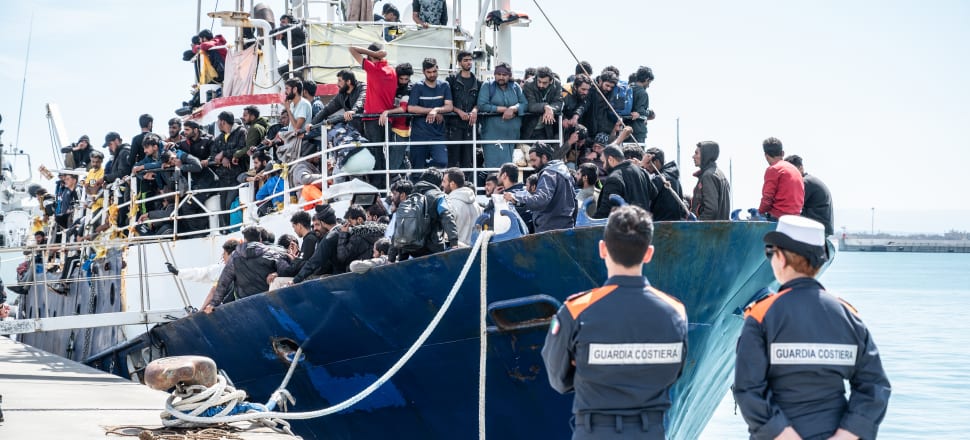
Under the new policy, member states reluctant to participate in refugee resettlement will face consequences if they continue to shirk responsibility
Opinion: Last week marked a significant milestone in Europe’s ongoing struggles to navigate the complex issue of migration. After years of fraught discussions, the European Union finally reached a consensus on a new refugee policy.
At a time when the continent is grappling with the largest influx of migrants since the 2015 refugee crisis, this development is crucial and overdue.
READ MORE:
* UN refugee agency criticises mass arrivals crackdown
* Inclusivity over prejudice: Immigration bill lacks human rights
* Eyebrow-raising $25m to prevent 'boat people'
* Why can’t the west welcome all refugees?
The balancing act the EU must perform is a delicate one, fraught with challenges. It is a tug of war between humanitarian obligations and practical limitations on the number of newcomers Europe can realistically absorb.
It is also a task that divides the EU membership between countries traditionally open to refugees and others vehemently opposed to accepting any.
One country that understands this all too well is Italy.
Sitting on the front line of Europe’s migrant crisis, Italy has shouldered the brunt of the surge in arrivals. The geographical reality of its location has made it the initial point of entry for many refugees seeking to enter the EU.
Across different administrations over the past decades, Italy has pleaded for a revised deal with the EU to alleviate these pressures. Under its new Prime Minister, Giorgia Meloni, Italy finally has one.
The proposed Common European Asylum System, with its combination of increased efficiency, shared responsibility, and stricter controls, is perhaps all that is possible today
Labelled the ‘Common European Asylum System’ (CEAS), the new policy proposes a unified method for processing asylum applications across all EU member states. Its goal is to expedite the process and reduce the backlog of cases. The target is to finalise decisions within eight weeks of arrival at EU border checkpoints.
This is a sharp departure from the previous ‘Dublin’ rules, which stipulated that the countries in which refugees first set foot bore sole responsibility for processing them. But that did not automatically mean they would then stay there. Under the new asylum system, frontline nations – such as Italy and Greece – will no longer be the exclusive custodians of asylum decisions.
Under the new policy, member states reluctant to participate in refugee resettlement will face consequences if they continue to shirk responsibility. The EU is getting serious about enforcing participation and solidarity.
Countries that refuse to accept refugees are now staring down the barrel of substantial financial penalties – to the tune of €20,000 per refused refugee. However, the effectiveness of the new asylum system rests on an assumption that countries refusing to participate in refugee settlement will then cooperate in paying fines.
The new rules will also impose stricter controls on the arrivals themselves. Refugees from countries deemed ‘safe’ by the EU, or who have a lower than 20 percent chance of gaining refugee status, potentially face a swift return to their home countries.
The change introduces an even more controversial point: refugees from countries with low chances of achieving refugee status will no longer have access to a full trial. This represents a significant shift in how asylum seekers are treated, and it is yet unclear what the ramifications will be on refugee rights under international conventions.
However, even these revised regulations are not universally palatable. Italy and Germany are likely to back the new asylum system framework, but hardline anti-immigration countries such as Hungary and Poland remain in staunch opposition. Despite its more stringent stance towards migration, for some nations, the new policy is still not strict enough.
The next chapter in this saga will be written by the EU Parliament and the EU Council. Their approval, or rejection, of the proposed changes will shape the future landscape of Europe’s approach to migration.
It remains a Sisyphean task to square the circle between upholding the right to claim asylum, ensuring political acceptability of refugees, and attaining consensus among all EU member states.
The new asylum system policy may be stringent, but it also underlines deep-seated divisions within the EU over migration. The dichotomy of views on a shared issue, national perspectives, and collective action on migration is a big challenge for the EU.
And so the critical question remains: will this policy work in practice? And will it have the desired effect of reducing refugee numbers overall?
No policy can solve the refugee crisis entirely, but the Common European Asylum System marks a significant departure from the previous system.
It is a cliché to say that politics is the art of the possible. But the proposed Common European Asylum System, with its combination of increased efficiency, shared responsibility, and stricter controls, is perhaps all that is possible today.
If the new asylum system is successful, the numbers of refugees risking their lives and sometimes dying in desperate attempts to cross the Mediterranean will most likely fall. No matter one’s political leanings, that alone would be a positive outcome.
But is this enough to aim for? And is it realistic?
This is not the first time the EU has faced the refugee question, and it is unlikely to be the last. As individuals flee political instability, poverty, and persecution in their home countries, the EU pulls them with its lure of safety, freedom, and opportunity.
As long as these push-and-pull factors exist, the challenge of managing migration will remain.
Previous policies have faltered because of divergent European interests and implementation challenges, and the new system also faces these potential pitfalls.
In all likelihood, it will be a new chapter in the EU’s immigration saga. But it is unlikely to be the happy ending Europe’s politicians may hope for.







